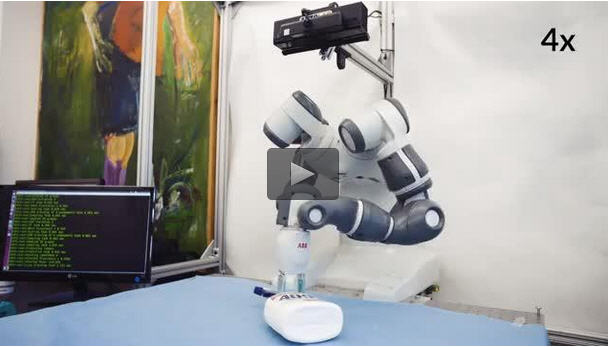Meet the most nimble-fingered robot ever built

To reduce data collection time for deep learning of robust robotic grasp plans, we explore training from a synthetic dataset of 6.7 million point clouds, grasps, and robust analytic grasp metrics generated from thousands of 3D models from Dex-Net 1.0 in randomized poses on a table. We use the resulting dataset, Dex-Net 2.0, to train a Grasp Quality Convolutional Neural Network (GQ-CNN) model that rapidly classifies grasps as robust from depth images and the position, angle, and height of the gripper above a table. Experiments with over 1,000 trials on an ABB YuMi comparing grasp planning methods on singulated objects suggest that a GQ-CNN trained with only synthetic data from Dex-Net 2.0 can be used to plan grasps in 0.8s with a success rate of 93% on eight known objects with adversarial geometry and is 3x faster than registering point clouds to a precomputed dataset of objects and indexing grasps. The GQ-CNN is also the highest performing method on a dataset of ten novel household objects, achieving 99% precision on test objects. (Video) Credit: Adriel Olmos, CITRIS Media
Berkeley professor Ken Goldberg, postdoctoral researcher Jeff Mahler and the Laboratory for Automation Science and Engineering (AUTOLAB) created the robot, called DexNet 2.0.
DexNet 2.0's high grasping success rate means that this technology could soon be applied in industry, with the potential to revolutionize manufacturing and the supply chain.
DexNet 2.0 gained its highly accurate dexterity through a process called deep learning. The researchers built a vast database of three-dimensional shapes — 6.7 million data points in total — that a neural network uses to learn grasps that will pick up and move objects with irregular shapes.
The neural network was then connected to a 3D sensor and a robotic arm. When an object is placed in front of DexNet 2.0, it quickly studies the shape and selects a grasp that will successfully pick up and move the object 99 percent of the time.
DexNet 2.0 is also three times faster than its previous version.
DexNet 2.0 was featured as the cover story of the latest issues of MIT Technology Review, which called DexNet 2.0 “the most nimble-fingered robot yet.”
The complete paper will be published in July.
Media Contact
All latest news from the category: Power and Electrical Engineering
This topic covers issues related to energy generation, conversion, transportation and consumption and how the industry is addressing the challenge of energy efficiency in general.
innovations-report provides in-depth and informative reports and articles on subjects ranging from wind energy, fuel cell technology, solar energy, geothermal energy, petroleum, gas, nuclear engineering, alternative energy and energy efficiency to fusion, hydrogen and superconductor technologies.
Newest articles

Sea slugs inspire highly stretchable biomedical sensor
USC Viterbi School of Engineering researcher Hangbo Zhao presents findings on highly stretchable and customizable microneedles for application in fields including neuroscience, tissue engineering, and wearable bioelectronics. The revolution in…

Twisting and binding matter waves with photons in a cavity
Precisely measuring the energy states of individual atoms has been a historical challenge for physicists due to atomic recoil. When an atom interacts with a photon, the atom “recoils” in…

Nanotubes, nanoparticles, and antibodies detect tiny amounts of fentanyl
New sensor is six orders of magnitude more sensitive than the next best thing. A research team at Pitt led by Alexander Star, a chemistry professor in the Kenneth P. Dietrich…





















